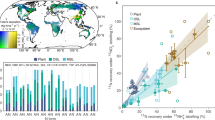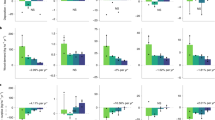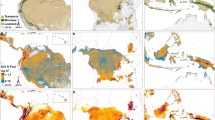Abstract
Nitrogen (N) limits the productivity of many ecosystems worldwide, thereby restricting the ability of terrestrial ecosystems to offset the effects of rising atmospheric CO2 emissions naturally1,2. Understanding input pathways of bioavailable N is therefore paramount for predicting carbon (C) storage on land, particularly in temperate and boreal forests3,4. Paradigms of nutrient cycling and limitation posit that new N enters terrestrial ecosystems solely from the atmosphere. Here we show that bedrock comprises a hitherto overlooked source of ecologically available N to forests. We report that the N content of soils and forest foliage on N-rich metasedimentary rocks (350–950 mg N kg−1) is elevated by more than 50% compared with similar temperate forest sites underlain by N-poor igneous parent material (30–70 mg N kg−1). Natural abundance N isotopes attribute this difference to rock-derived N: 15N/14N values for rock, soils and plants are indistinguishable in sites underlain by N-rich lithology, in marked contrast to sites on N-poor substrates. Furthermore, forests associated with N-rich parent material contain on average 42% more carbon in above-ground tree biomass and 60% more carbon in the upper 30 cm of the soil than similar sites underlain by N-poor rocks. Our results raise the possibility that bedrock N input may represent an important and overlooked component of ecosystem N and C cycling elsewhere.
This is a preview of subscription content, access via your institution
Access options
Subscribe to this journal
Receive 51 print issues and online access
$199.00 per year
only $3.90 per issue
Buy this article
- Purchase on Springer Link
- Instant access to full article PDF
Prices may be subject to local taxes which are calculated during checkout



Similar content being viewed by others
References
Vitousek, P. M. & Howarth, R. W. Nitrogen limitation on land and in the sea: how can it occur? Biogeochemistry 13, 87–115 (1991)
Oren, R. et al. Soil fertility limits carbon sequestration by forest ecosystems in a CO2-enriched atmosphere. Nature 411, 469–472 (2001)
Wang, Y. P. & Houlton, B. Z. Nitrogen constraints on terrestrial carbon uptake: implications for the global carbon–climate feedback. Geophys. Res. Lett. 36 L24403 10.1029/2009gl041009 (2009)
Magnani, F. et al. The human footprint in the carbon cycle of temperate and boreal forests. Nature 447, 848–850 (2007)
Galloway, J. N. in Treatise on Geochemistry Vol. 8 (ed. W. H. Schlesinger ) 557–583 (Elsevier Pergamon, 2004)
Holloway, J. M. & Dahlgren, R. A. Nitrogen in rock: occurrences and biogeochemical implications. Glob. Biogeochem. Cycles 16 1118 10.1029/2002gb001862 (2002)
Walvoord, M. A. et al. A reservoir of nitrate beneath desert soils. Science 302, 1021–1024 (2003)
Stevenson, F. J. On the presence of fixed ammonium in rocks. Science 130, 221–222 (1959)
Cornwell, S. M. & Stone, E. L. Availability of nitrogen to plants in acid coal mine spoils. Nature 217, 768–769 (1968)
Walker, T. W. & Syers, J. K. The fate of phosphorus during pedogenesis. Geoderma 15, 1–19 (1976)
Strathouse, S. M., Sposito, G., Sullivan, P. J. & Lund, L. J. Geologic nitrogen—a potential geochemical hazard in the San Joaquin Valley, California. J. Environ. Qual. 9, 54–60 (1980)
Holloway, J. M., Dahlgren, R. A., Hansen, B. & Casey, W. H. Contribution of bedrock nitrogen to high nitrate concentrations in stream water. Nature 395, 785–788 (1998)
Irwin, W., Wolfe, E. W., Blake, M. C. & Cunningham, C. G. Geologic map of the Pickett Peak quadrangle, Trinity County, California (US Geological Survey Map GQ-1111, 1974)
Dahlgren, R. A. Soil acidification and nitrogen saturation from weathering of ammonium-bearing rock. Nature 368, 838–841 (1994)
Aalto, K. R. in Geological Studies in the Klamath Mountains Province, California and Oregon. A Volume in Honor of William P. Irwin (eds Snoke, A. W. & Barnes, C. G. ) 451–464 (Geological Society of America Special Papers, vol. 410, 2006)
Capo, R. C., Stewart, B. W. & Chadwick, O. A. Strontium isotopes as tracers of ecosystem processes: theory and methods. Geoderma 82, 197–225 (1998)
National Atmospheric Deposition Program . National Atmospheric Deposition Program 2008 Annual Summary (NADP Data Report 2009–01) (Univ. of Illinois at Urbana-Champaign, 2009)
Sollins, P., Grier, C. C., McCorison, F. M., Cromack, K. & Fogel, R. The internal element cycles of an old-growth Douglas-fir ecosystem in western Oregon. Ecol. Monogr. 50, 261–285 (1980)
Cleveland, C. C. et al. Global patterns of terrestrial biological nitrogen (N2) fixation in natural ecosystems. Glob. Biogeochem. Cycles 13, 623–645 (1999)
Li, Y. H. Distribution patterns of the elements in the ocean—a synthesis. Geochim. Cosmochim. Acta 55, 3223–3240 (1991)
Timmer, V. R. & Stone, E. L. Comparative foliar analysis of young Balsam fir fertilized with nitrogen, phosphorus, potassium, and lime. Soil Sci. Soc. Am. J. 42, 125–130 (1978)
Amundson, R. et al. Global patterns of the isotopic composition of soil and plant nitrogen. Glob. Biogeochem. Cycles 17, 10.1029/2002gb001903. (2003)
Martinelli, L. A. et al. Nitrogen stable isotopic composition of leaves and soil: tropical versus temperate forests. Biogeochemistry 46, 45–65 (1999)
Houlton, B. Z. & Bai, E. Imprint of denitrifying bacteria on the global terrestrial biosphere. Proc. Natl Acad. Sci. USA 106, 21713–21716 (2009)
Hobbie, E. A., Macko, S. A. & Williams, M. Correlations between foliar delta N-15 and nitrogen concentrations may indicate plant–mycorrhizal interactions. Oecologia 122, 273–283 (2000)
LeBauer, D. S. & Treseder, K. K. Nitrogen limitation of net primary productivity in terrestrial ecosystems is globally distributed. Ecology 89, 371–379 (2008)
Thomas, R. Q., Canham, C. D., Weathers, K. C. & Goodale, C. L. Increased tree carbon storage in response to nitrogen deposition in the US. Nature Geosci. 3, 13–17 (2010)
Keeler-Wolf, T. Ecological surveys of Forest Service Research Natural Areas in California (Gen. Tech. Rep. PSW-125) (Pacific Southwest Research Station, Forest Service, 1990)
Galloway, J. N., Schlesinger, W. H., Levy, H., II, Michaels, A. & Schnoor, J. L. Nitrogen fixation: anthropogenic enhancement–environmental response. Glob. Biogeochem. Cycles 9, 235–252 (1995)
Blatt, H. & Jones, R. L. Proportions of exposed igneous, metamorphic, and sedimentary rocks. Geol. Soc. Am. Bull. 86, 1085–1088 (1975)
McKinney, C. R., McCrea, J. M., Epstein, S., Allen, H. A. & Urey, H. C. Improvements in mass spectrometers for the measurement of small differences in isotope abundance ratios. Rev. Sci. Instrum. 21, 724–730 (1950)
Blake, G. R. & Hartge, K. H. in Methods of Soil Analysis—Physical and Mineralogical Methods Vol. 9 (ed. Klute, A. ) Ch. 13 364–367 (Soil Science Society of America, 1986)
Eshel, G., Levy, G. J., Mingelgrin, U. & Singer, M. J. Critical evaluation of the use of laser diffraction for particle-size distribution analysis. Soil Sci. Soc. Am. J. 68, 736–743 (2004)
Brauer, K. & Hahne, K. Methodical aspects of the N-15-analysis of Precambrian and Palaeozoic sediments rich in organic matter. Chem. Geol. 218, 361–368 (2005)
Carlson, R. M. Automated seperaration and conductimetric determination of ammonia and dissolved carbon dioxide. Anal. Chem. 50, 1528–1531 (1978)
R Development Core Team . R: A Language and Environment for Statistical Computing v.2.12.1 (R Foundation for Statistical Computing, 2010)
USDA Forest Service . 2007 Mendocino National Forest Vegetation Inventory (Pacific Southwest Research Station, 2010)
USDA Forest Service . 2007 Shasta–Trinity National Forest Vegetation Inventory (Pacific Southwest Research Station, 2010)
USDA Forest Service . 2007 Six Rivers National Forest Vegetation Inventory (Pacific Southwest Research Station, 2010)
Bishop, D. G. South-Fork Mountain Schist at Black-Butte and Cottonwood Creek, northern California. Geology 5, 595–599 (1977)
Jayko, A. S. & Blake, M. C. Deformation of the eastern Franciscan belt, northern California. J. Struct. Geol. 11, 375–390 (1989)
Lanphere, M. A., Blake, M. C. & Irwin, W. P. Early Cretaceous metamorphic age of South Fork Mountain Schist in northern Coast Ranges of California. Am. J. Sci. 278, 798–815 (1978)
Jennings, C. W. & Strand, R. Geologic Map of California: Ukiah Sheet (California Division of Mines and Geology, 1960)
Strand, R. G. Geologic Map of California: Redding Sheet (California Division of Mines and Geology, 1962)
Blake, M. S., Helley, E. J., Jayko, A. S., Jones, D. L. & Ohlin, H. N. Geologic Map of the Willows 1:100,000 Quadrangle, California (US Geological Survey Open-File Report OF-92-271, 1992)
USDA Forest Service . Existing Vegetation—CALVEG Geodatabase (USDA Forest Service, Pacific Southwest Region Remote Sensing Lab, 2009)
USDA Forest Service . Trinity Serpentine Soil Survey (Pacific Southwest Research Station, 2004)
McGaughey, R. J. Stand Visualization System v. 3.3 (United States Department of Agriculture, Forest Service, Pacific Northwest Research Station, 2004)
Beaudette, D. E. & O’Geen, A. T. A 1 km Scale, Gridded Soils Database for California (California Soil Resource Lab, Univ. of California, Davis, 2010)
Gesch, D. B. in Digital Elevation Model Technologies and Applications: The DEM User Manual 2nd edn (ed. Maune, D. ) 99–118 (American Society for Photogrammetry and Remote Sensing, 2007)
Fu, P. & Rich, P. M. A geometric solar radiation model with applications in agriculture and forestry. Comput. Electron. Agric. 37, 25–35 (2002)
Environmental Systems Research Group . ArcGIS Desktop v. 9.3 (Environmental Systems Research Group, Redlands, 2010)
The PRISM Group at Oregon State University . United States Average Monthly or Annual Precipitation, 1971–2000 (Oregon State Univ., 2006)
The PRISM Group at Oregon State University . United States Average Monthly or Annual Maximum Temperature, 1971–2000 (Oregon State Univ., 2006)
Jenkins, J. C., Chojnacky, D. C., Heath, L. S. & Birdsey, R. A. National-scale biomass estimators for United States tree species. For. Sci. 49, 12–35 (2003)
Reinhardt, E. D., Crookston, N. L. & Rebain, S. A. The Fire and Fuels Extension to the Forest Vegetation Simulator (United States Department of Agriculture, Forest Service, 2003)
Forest Inventory and Analysis Program . The Forest Inventory and Analysis Database: Database Description and Users Manual Version 3.0 for Phase 2, Revision 1. (United States Department of Agriculture, Forest Service, 2008)
California Department of Forestry and Fire Protection . Fire Perimeters (1923 to 2008) for Wildfire in the State of California (State of California, 2009)
Reineke, L. H. Perfecting a stand-density index for even-aged forests. J. Agric. Res. 46, 627–638 (1933)
Smith, E. M., Larson, B. C., Kelty, M. J. & Ashton, P. M. S. The Practice of Silviculture: Applied Forest Ecology 9th edn (Wiley, 1996)
Akaike, H. A new look at the statistical model identification. IEEE Trans. Automat. Contr. 16, 716–723 (1974)
Fox, J. & Weisberg, S. An (R) Companion to Applied Regression (Sage, 2011)
Lorenz, K. & Lal, R. Carbon Sequestration in Forest Ecosystems (Springer, 2010)
de Vries, W. et al. Ecologically implausible carbon response? Nature 451, E1–E3 (2008)
Townsend, A. R., Braswell, B. H., Holland, E. A. & Penner, J. E. Spatial and temporal patterns in terrestrial carbon storage due to deposition of fossil fuel nitrogen. Ecol. Appl. 6, 806–814 (1996)
Riebe, C. S., Kirchner, J. W. & Finkel, R. C. Sharp decrease in long-term chemical weathering rates along an altitudinal transect. Earth Planet. Sci. Lett. 218, 421–434 (2004)
Lock, J., Kelsey, H., Furlong, K. & Woolace, A. Late Neogene and Quaternary landscape evolution of the northern California Coast Ranges: evidence for Mendocino Triple Junction tectonics. Geol. Soc. Am. Bull. 118, 1232–1246 10.1130/b25885.1. (2006)
Mitchell, C. E., Vincent, P., Weldon, R. J. & Richards, M. A. Present-day vertical deformation of the Cascadia Margin, Pacific Northwest, United States. J. Geophys. Res. Solid Earth 99, 12257–12277 (1994)
Kelsey, H. M., Engebretson, D. C., Mitchell, C. E. & Ticknor, R. L. Topographic form of the Coast Ranges of the Cascadia Margin in relation to coastal uplift rates and plate subduction. J. Geophys. Res. Solid Earth 99, 12245–12255 (1994)
Merritts, D. & Bull, W. B. Interpreting quaternary uplift rates at the Mendocino Triple Junction, northern California, from uplifted marine terraces. Geology 17, 1020–1024 (1989)
Dahlgren, R. A. Geologic nitrogen as a source of soil acidity. Soil Sci. Plant Nutr. 51, 719–723 (2005)
Casey, W. H. & Sposito, G. On the temperature-dependence of mineral dissolution rates. Geochim. Cosmochim. Acta 56, 3825–3830 (1992)
Brady, P. V. & Carroll, S. A. Direct effects of CO2 and temperature on silicate weathering—possible implications for climate control. Geochim. Cosmochim. Acta 58, 1853–1856 (1994)
Verrall, R. E. Determination of activity coefficients for ammonium chloride at 25 °C. J. Solution Chem. 4, 319–329 (1974)
Soil Survey Staff . Soil Survey Geographic (SSURGO) Database for California (United States Department of Agriculture, Natural Resources Conservation Service, 2010)
Beaudette, D. E. & O’Geen, A. T. Algorithms for Quantitative Pedology: A Toolkit for Soil Scientists (California Soil Resource Lab, Univ. of California, Davis, 2010)
Acknowledgements
We thank the United States Forest Service (USFS) for access and insight, particularly D. Young and B. Rust of the Shasta-Trinity National Forest; C. Ramirez, C. Clark and D. Beardsley of USFS Region 5 Remote Sensing Office; and M. North of the Pacific Southwest Research Station for discussion of FIA modelling. I. Fisher, E. Hendel, K. Mayfield and S. Prentice assisted with sample preparation and fieldwork, and E. Brown assisted in processing strontium isotope samples. D. Beaudette provided assistance in analysing soil data. This work was supported by grants from the David and Lucile Packard Foundation (to B.Z.H. and R.A.D.) the Andrew W. Mellon Foundation (to B.Z.H.) and the Kearney Foundation of Soil Science (to R.A.D.).
Author information
Authors and Affiliations
Contributions
S.L.M., B.Z.H. and R.A.D. contributed to the experimental design and collection of field samples. S.L.M. performed sample processing and laboratory analysis. S.L.M. designed and implemented the FIA modelling component. S.L.M., B.Z.H. and R.A.D. contributed to the interpretation of laboratory data, modelling results and manuscript preparation.
Corresponding author
Ethics declarations
Competing interests
The authors declare no competing financial interests.
Supplementary information
Supplementary Information
This file contains 4 Supplementary Discussions, Supplementary Tables 1-7, Supplementary Figures 1-6 with legends and additional references. (PDF 559 kb)
Rights and permissions
About this article
Cite this article
Morford, S., Houlton, B. & Dahlgren, R. Increased forest ecosystem carbon and nitrogen storage from nitrogen rich bedrock. Nature 477, 78–81 (2011). https://doi.org/10.1038/nature10415
Received:
Accepted:
Published:
Issue Date:
DOI: https://doi.org/10.1038/nature10415
This article is cited by
-
Dynamic carbon-nitrogen coupling under global change
Science China Life Sciences (2023)
-
From burned slopes to streams: how wildfire affects nitrogen cycling and retention in forests and fire-prone watersheds
Biogeochemistry (2022)
-
Bedrock geochemistry influences vegetation growth by regulating the regolith water holding capacity
Nature Communications (2020)
-
The pedogenic Walker and Syers model under high atmospheric P deposition rates
Biogeochemistry (2020)
-
Decadal-scale decoupling of soil phosphorus and molybdenum cycles by temperate nitrogen-fixing trees
Biogeochemistry (2020)
Comments
By submitting a comment you agree to abide by our Terms and Community Guidelines. If you find something abusive or that does not comply with our terms or guidelines please flag it as inappropriate.



